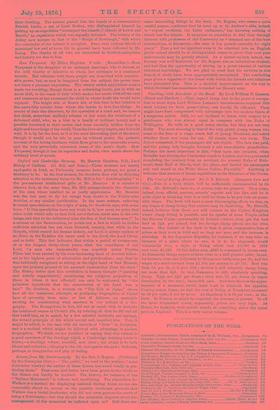Lindores Abbey, and its Burgh of Newburgh. By Alexander Laing.
(Edmonston and Douglas.)—Mr. Laing begins ab eve. "Prehistoric Times," "The Roman Invasion," "Celt and Teuton," "Pagan Re- ligions," dm., are discussed in successive chapters. We feel that we are approaching the subject when we get to " Benediotine Monasteries ;" at last, at page 50, we reach "Lindores Abbey" itself, and we part with it at page 129, where we read of how John Leslie, Bishop of Ross, and last of the Abbots, died in exile near Brussels. The Abbey authorities bad distinguished them- selves unfavourably by persecuting the precursors of the Reforma- tion movement. James Reshy and Paul Craa ar, and the more famous Patrick Hamilton, were condemned by the court which it was privi- leged to hold. Lindores was sacked by "a company of good Christians" from Dundee. Afterwards John Knox and his friends reformed it in vigorous fashion :—" Their altars overthrew we, their idols, vestments of idolatrie, and mass-books we burnt in their presence, and commanded them to cast away their monkish habits." Eight days before the beautiful cathedral and monastic buildings of St. Andrew's had been ruthlessly destroyed. The reformed monks did not long amain in
their dwelling. The estates passed into the hands of a commendatorf Patrick Leslie, a son of Lord Rothes, who distinguished himself by getting up an expedition "to conquer the islands (? island) of Lewis and Mania," an expedition which was signally defeated. The history of the Abbey now merges in that of the "Burgh of Newburgh," with which the remainder of the volume is occupied. Some very curious details of municipal law and of town life in general have been collected by Mr. Laing. The thanks of all who are interested in Scottish antiquities and history are due to him.



































 Previous page
Previous page